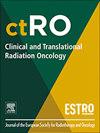磁共振图像引导在线自适应膀胱放射治疗中放射技师靶体积轮廓的评价
IF 2.7
3区 医学
Q3 ONCOLOGY
引用次数: 0
摘要
背景和目的阻碍在线mri引导放射治疗(MRIgRT)在MR Linac (MRL)上广泛临床实施的一个障碍是资源强度。具体来说,要求临床肿瘤学家/放射肿瘤学家(CO/RO)对每个部分进行在线轮廓。我们报告了对接受全膀胱MRIgRT的患者的治疗性放射技师(RTT)在线轮廓的评估。材料和方法试验组进行了一项轮廓训练方案。使用dice similarity coefficient (DSC)、hausdorff distance (HD)、mean distance to agreement (MDA)以及Raystation治疗计划系统(TPS) (RaySearch Laboratories)的敏感性和特异性体积指标,对95个分数的RTT和CO/RO临床靶体积(CTV)轮廓进行评估。此外,CTV DSC是根据在钦佩(Elekta AB,瑞典斯德哥尔摩)中生成的同时真实性和性能水平估计(STAPLE)进行评估的。在剂量学分析(Monaco, Elekta AB)中,使用rtt定义的轮廓线生成的在线适应性治疗计划,使用CO/ROs描绘的离线轮廓线进行评估。结果RTT与CO/RO等值线的比较发现,DSC的CTV中位数(四分位数范围)为0.92 (0.91-0.94),MDA为0.11 (0.09-0.12)cm, HD为0.63 (0.53-0.72)cm,敏感性和特异性分别为0.94(0.90-0.96)和0.95(0.92 - 0.97)。在剂量学分析中,65%(30/46)的方案达到了V52.25 Gy >的最佳PTV覆盖率;98%,所有计划都达到了52.25 Gy的强制性PTV覆盖率;95%。结论经有效训练后,RTT全膀胱CTV轮廓与CO/RO轮廓相当。临床实施将从MRL膀胱治疗中释放CO/ROs,减少在线工作流程的资源强度。本文章由计算机程序翻译,如有差异,请以英文原文为准。
Evaluation of therapeutic radiographer target volume contouring for magnetic resonance image guided online adaptive bladder radiotherapy
Background and purpose
One barrier to wider clinical implementation of online MRI-guided radiotherapy (MRIgRT) on the MR Linac (MRL) is resource intensity. Specifically, the requirement for a clinical oncologist/radiation oncologist (CO/RO) to perform online contouring each fraction. We report an evaluation of therapeutic radiographer (RTT) online contouring for patients receiving whole bladder MRIgRT.
Materials and methods
RTTs undertook a contouring training programme. RTT and CO/RO clinical target volume (CTV) contours from 95 fractions were assessed using dice similarity coefficient (DSC), hausdorff distance (HD), mean distance to agreement (MDA), sensitivity and specificity volume metrics on the Raystation treatment planning system (TPS) (RaySearch Laboratories). Additionally, CTV DSC was evaluated with respect to a simultaneous truth and performance level estimation (STAPLE) generated in ADMIRE (Elekta AB, Stockholm, Sweden). In dosimetric analysis (Monaco, Elekta AB), online adaptive treatment plans, which had been generated using RTT-defined contours, were evaluated using contours delineated offline by CO/ROs.
Results
Comparison of RTT versus CO/RO contours found the CTV median (interquartile range) (IQR) for DSC was 0.92 (0.91–0.94), MDA was 0.11 (0.09–0.12) cm, and HD was 0.63 (0.53–0.72) cm, sensitivity and specificity were 0.94 (0.90–0.96) and 0.95 (0.92–0.97) respectively. In dosimetric analysis, 65 % (30/46) plans met optimal PTV coverage of V52.25 Gy > 98 % and all plans met mandatory PTV coverage of V52.25 Gy > 95 %.
Conclusion
Following effective training, evaluation results demonstrate RTT whole bladder CTV contours to be comparable to CO/RO contours. Clinical implementation will release CO/ROs from MRL bladder treatments, reducing resource intensity of online workflows.
求助全文
通过发布文献求助,成功后即可免费获取论文全文。
去求助
来源期刊

Clinical and Translational Radiation Oncology
Medicine-Radiology, Nuclear Medicine and Imaging
CiteScore
5.30
自引率
3.20%
发文量
114
审稿时长
40 days
 求助内容:
求助内容: 应助结果提醒方式:
应助结果提醒方式:


